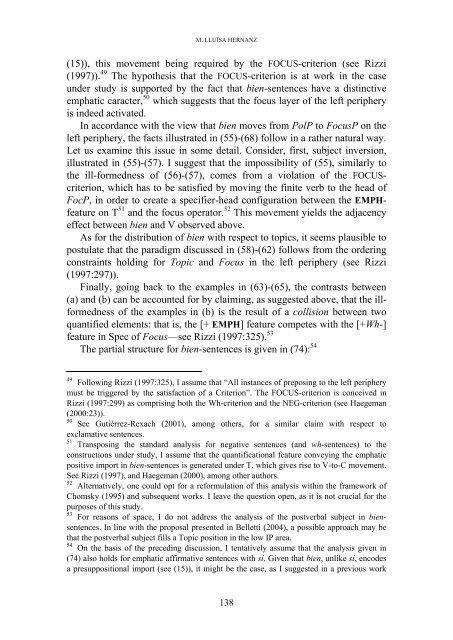Emphatic Polarity and C in Spanish - Lear
Emphatic Polarity and C in Spanish - Lear
Emphatic Polarity and C in Spanish - Lear
Create successful ePaper yourself
Turn your PDF publications into a flip-book with our unique Google optimized e-Paper software.
M. LLUÏSA HERNANZ<br />
(15)), this movement be<strong>in</strong>g required by the FOCUS-criterion (see Rizzi<br />
(1997)). 49 The hypothesis that the FOCUS-criterion is at work <strong>in</strong> the case<br />
under study is supported by the fact that bien-sentences have a dist<strong>in</strong>ctive<br />
emphatic caracter, 50 which suggests that the focus layer of the left periphery<br />
is <strong>in</strong>deed activated.<br />
In accordance with the view that bien moves from PolP to FocusP on the<br />
left periphery, the facts illustrated <strong>in</strong> (55)-(68) follow <strong>in</strong> a rather natural way.<br />
Let us exam<strong>in</strong>e this issue <strong>in</strong> some detail. Consider, first, subject <strong>in</strong>version,<br />
illustrated <strong>in</strong> (55)-(57). I suggest that the impossibility of (55), similarly to<br />
the ill-formedness of (56)-(57), comes from a violation of the FOCUScriterion,<br />
which has to be satisfied by mov<strong>in</strong>g the f<strong>in</strong>ite verb to the head of<br />
FocP, <strong>in</strong> order to create a specifier-head configuration between the EMPHfeature<br />
on T 51 <strong>and</strong> the focus operator. 52 This movement yields the adjacency<br />
effect between bien <strong>and</strong> V observed above.<br />
As for the distribution of bien with respect to topics, it seems plausible to<br />
postulate that the paradigm discussed <strong>in</strong> (58)-(62) follows from the order<strong>in</strong>g<br />
constra<strong>in</strong>ts hold<strong>in</strong>g for Topic <strong>and</strong> Focus <strong>in</strong> the left periphery (see Rizzi<br />
(1997:297)).<br />
F<strong>in</strong>ally, go<strong>in</strong>g back to the examples <strong>in</strong> (63)-(65), the contrasts between<br />
(a) <strong>and</strong> (b) can be accounted for by claim<strong>in</strong>g, as suggested above, that the illformedness<br />
of the examples <strong>in</strong> (b) is the result of a collision between two<br />
quantified elements: that is, the [+ EMPH] feature competes with the [+Wh-]<br />
feature <strong>in</strong> Spec of Focus—see Rizzi (1997:325). 53<br />
The partial structure for bien-sentences is given <strong>in</strong> (74): 54<br />
49<br />
Follow<strong>in</strong>g Rizzi (1997:325), I assume that “All <strong>in</strong>stances of prepos<strong>in</strong>g to the left periphery<br />
must be triggered by the satisfaction of a Criterion”. The FOCUS-criterion is conceived <strong>in</strong><br />
Rizzi (1997:299) as compris<strong>in</strong>g both the Wh-criterion <strong>and</strong> the NEG-criterion (see Haegeman<br />
(2000:23)).<br />
50<br />
See Gutiérrez-Rexach (2001), among others, for a similar claim with respect to<br />
exclamative sentences.<br />
51<br />
Transpos<strong>in</strong>g the st<strong>and</strong>ard analysis for negative sentences (<strong>and</strong> wh-sentences) to the<br />
constructions under study, I assume that the quantificational feature convey<strong>in</strong>g the emphatic<br />
positive import <strong>in</strong> bien-sentences is generated under T, which gives rise to V-to-C movement.<br />
See Rizzi (1997), <strong>and</strong> Haegeman (2000), among other authors.<br />
52<br />
Alternatively, one could opt for a reformulation of this analysis with<strong>in</strong> the framework of<br />
Chomsky (1995) <strong>and</strong> subsequent works. I leave the question open, as it is not crucial for the<br />
purposes of this study.<br />
53<br />
For reasons of space, I do not address the analysis of the postverbal subject <strong>in</strong> biensentences.<br />
In l<strong>in</strong>e with the proposal presented <strong>in</strong> Belletti (2004), a possible approach may be<br />
that the postverbal subject fills a Topic position <strong>in</strong> the low IP area.<br />
54<br />
On the basis of the preced<strong>in</strong>g discussion, I tentatively assume that the analysis given <strong>in</strong><br />
(74) also holds for emphatic affirmative sentences with sí. Given that bien, unlike sí, encodes<br />
a presuppositional import (see (15)), it might be the case, as I suggested <strong>in</strong> a previous work<br />
138

















